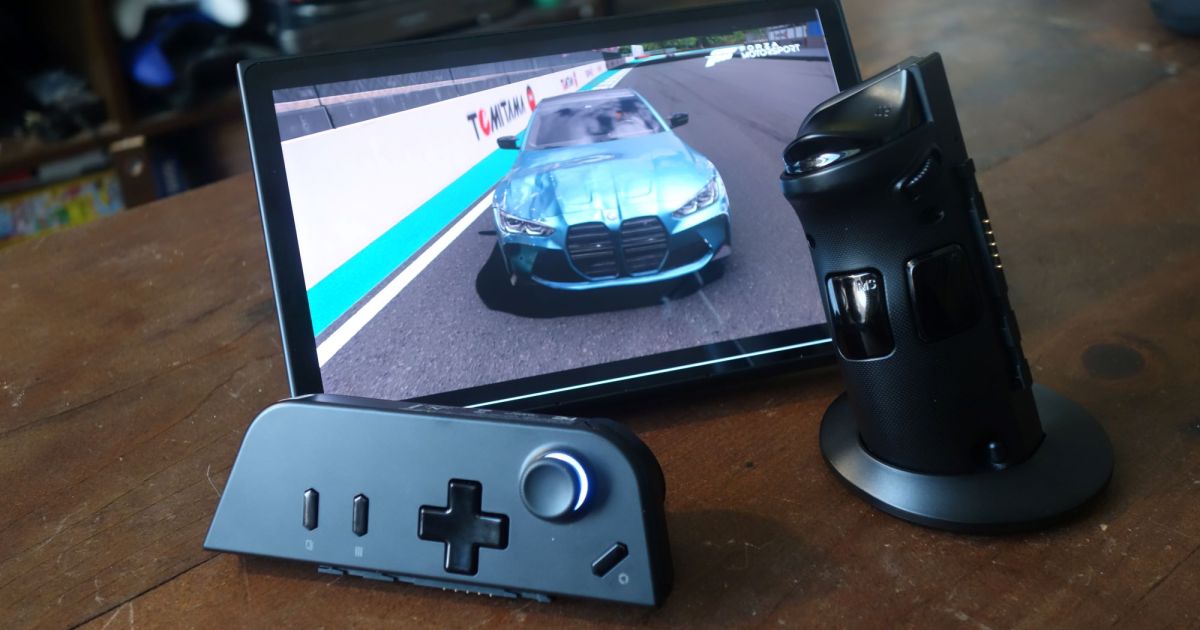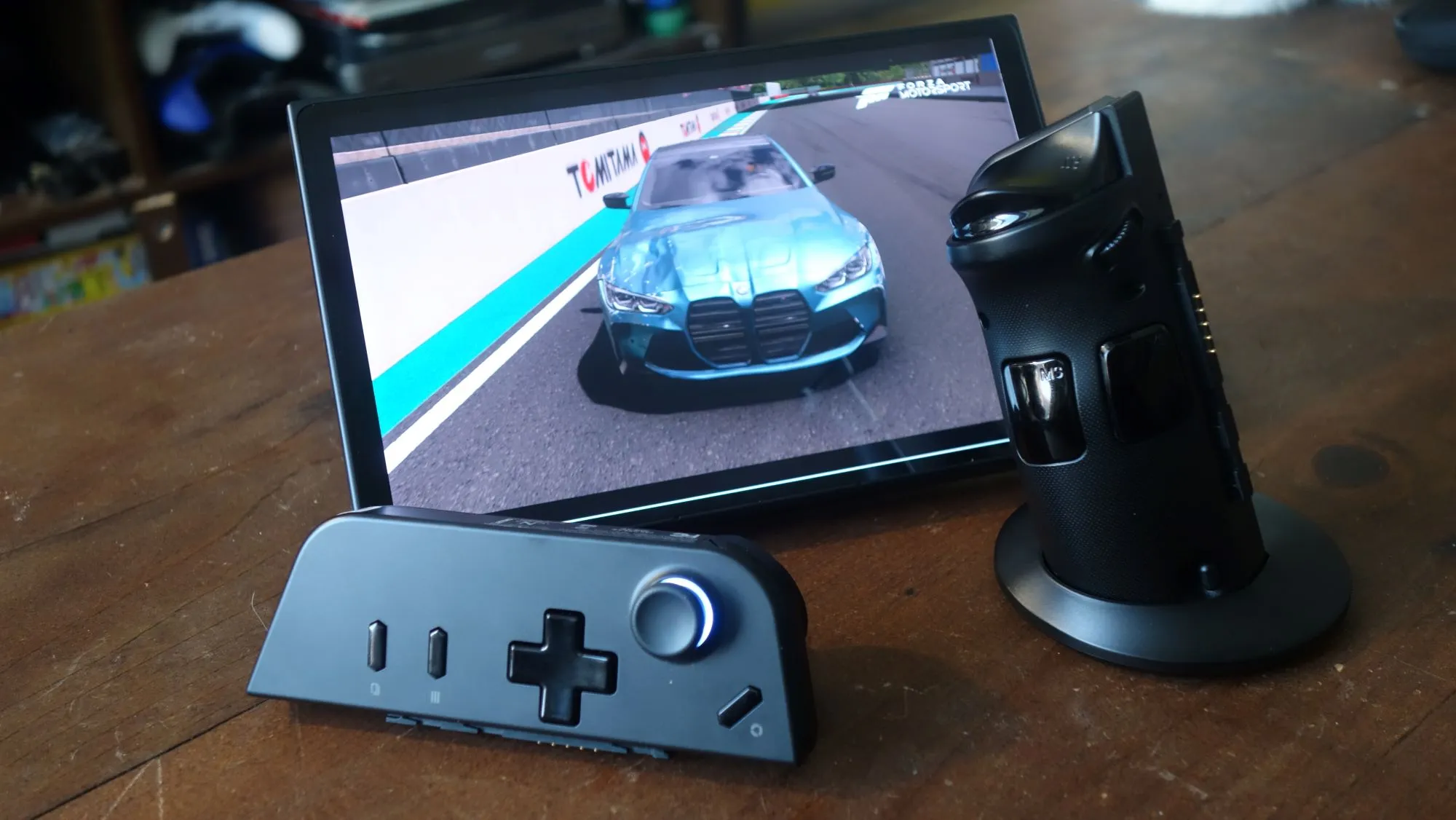
Lenovo Legion Go
MSRP $700.00
“The Legion Go is a creative portable PC that delivers innovative features, though they aren’t always the most practical ideas.”
Pros
- Strong build quality
- Top-of-the-line display
- Tabletop mode is great
- Matches ROG Ally in power
Cons
- Aspirational features are impractical
- Awkward button placements
- Legion Space needs work
I always love that special moment where an innovative tech device launches and I get to play with it for the first time. When I first got my hands on the Steam Deck, I felt like a kid on Christmas as I experimented with PC gaming on the go. It’s a cherished moment, but it’s not what I actually look forward to most whenever a new product category launches. My real excitement is reserved for a few years after that moment when competitors have to get creative to stand out in a new frontier that’s rapidly flooding with copycats. If you want to understand why I love that period so much, look no further than Legion Go.
It’s not that Lenovo’s Steam Deck competitor is a better alternative to Valve’s hit system. In a lot of ways, it’s a messy experiment that’ll need a lot of post-launch tweaking to get it up to speed with its rivals. It is, however, a piece of hardware that emphasizes the fun of good-spirited tech competition. In an effort to stand out, the Legion Go takes some wild swings that make it the most unique portable PC on the market today. It may not be the best option you can buy right now, but it could be the most influential one down the line.
The Legion Go checks a lot of the right boxes when it comes to its price, power, and the fantastic screen that sets a new bar for this kind of device. Combine that with its Nintendo Switch-inspired design and you’ve got a flexible gaming device with a lot of good ideas. For all its creativity, though, Lenovo often forgoes practicality in the name of innovation. It makes for a respectable, but niche gaming device that’s equally loaded with features and caveats.
Design and display
I’d bet that just about anyone who lays eyes on the Legion Go for the first time will have the same first reaction: “It’s that big!?” Yes, Lenovo’s system is Godzilla compared to what’s out on the market today. Weighing in at 1.88 pounds, it’s far heavier than the 1.65 pound Steam Deck or 1.34 pound ROG Ally. That’s a clue right off the bat that the Legion Go isn’t exactly the best option for those who want an easy on-the-go experience with minimal strain.
It’s a device that primarily shines in tabletop mode.
Lenovo does make the most of that hulking form factor. While it’s heavier than the Steam Deck, it’s about the same length and width as that device. The difference is in its 5.16-inch height — versus. the Steam Deck’s 4.6 inches — but there’s a good reason for all that extra space: the Legion Go’s best-in-class display. The handheld boasts an 8.8 inch, 16:10 QHD+ IPS display with impressive specs. It’s a 1600p screen and has a 144Hz refresh rate. Onboard tools give players room to dial that down to either 1200p or 800p, and take the refresh rate down to 60Hz if need be. It’s a big, bright, colorful display that goes above and beyond for a handheld like this.
The build quality is largely high across the board. It’s a sturdy system that’s easy to grip, even if it can be a strain to hold for long periods of time. What’s perhaps most impressive is its built-in kickstand that allows players to set the device up in a tabletop mode, just like the Switch. It’s a strong hinge that allows for a range of angles. It can get angled enough that I can plug something into its bottom USB4 charger while playing.
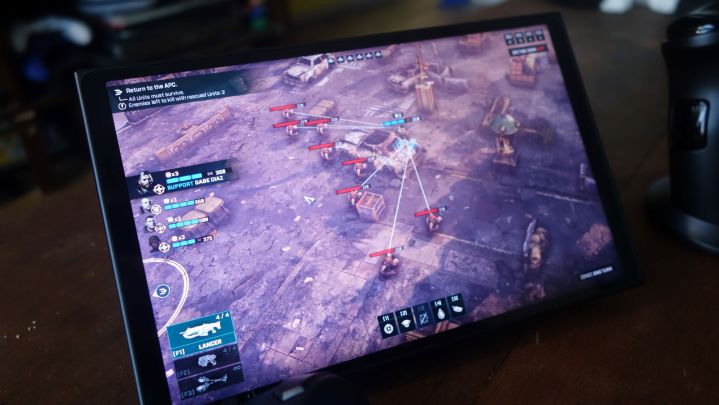
The package is rounded out by some standard features: Bluetooth 5.1 support, up to 1TB of storage, a microSD card reader, a headphone jack, two USB4 ports, and sizable vents on the top and back. It even comes with a handy storage case with a built-in charging slot. The only area where it isn’t up to snuff with the competition is with its weak speakers, which can’t get as loud as the ROG Ally’s — a shame considering it’s a device that primarily shines in tabletop mode. It’s also worth noting that its microSD card slot isn’t too far off from its top vents, a design decision that caused broken SD cards on the ROG Ally. It’s too early to say if the Legion Go avoids that problem, but the slot is spaced far enough away from the vents that it shouldn’t be a problem in theory.
Controls
The Legion Go’s biggest creative swings come from its approach to controls. At first glance, they seem standard. It’s anchored by two sturdy hall effect joysticks, seemingly high-quality face buttons, and responsive triggers. As a one-up on the Ally, it even has a right trackpad for those who want to simulate a mouse. It’s not nearly as responsive as the Steam Deck’s pads, but it’s a nice extra for those who were disappointed that the ROG Ally didn’t have any of its own.
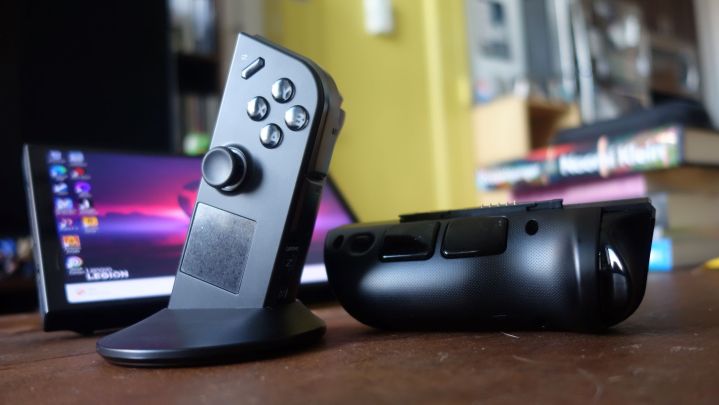
That setup isn’t without its flaws. The trackpad is a little low for comfort and it sports a surprisingly poor D-pad that’s not ideal for diagonal inputs. Its most frustrating flaw comes from its baffling menu button placements. The two buttons sitting where every major controller’s menu buttons are actually open up Lenovo’s Legion Space app. The proper menu buttons are on the bottom of the left controller, which takes a lot of brain-rewiring to get used to.
What’s more commendable is that the controllers can actually be detached from the system like (very thick) Joy-cons. That, combined with the kickstand, makes the Legion Go more enticing as a tabletop device than a handheld. I’ve spent most of my gaming time treating it like a small laptop with a powerful display. That’s an ideal use case, as the heavy design and loud vents don’t make it the most portable-friendly device.
Lenovo seems to understand where the Legion Go shines most and has built its most distinct feature around that. FPS mode is a unique setting that turns the right controller into a mouse when docking it in a magnetic circle built to slide around a table. It’s an inventive idea that takes Nintendo’s Joy-con setup to another level. Though like many of the Legion Go’s defining features, it’s more a neat party trick than a practical way to play.
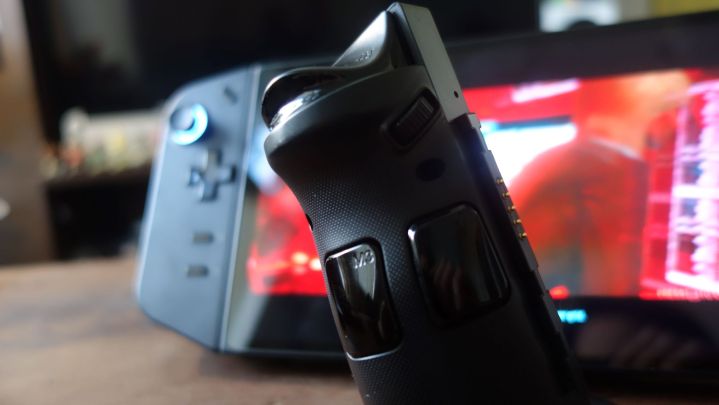
I’ve found that FPS mode is great for some specific games that are mostly controlled by mouse clicks. Gears Tactics is a perfect use case here, as I can move the controller around and click to do just about anything. Ironically, it’s far less useful in first-person shooters — the very genre the mode is named after. In trying to play Battlebit Remastered in the mode, I’d quickly realize the inherent flaw of a mouse and keyboard mode with no keyboard. I could aim and shoot just fine, but I simply didn’t have enough buttons to strafe, heal, drive vehicles, etc.
The Legion Go tries to account for that with the addition of several extra buttons, including a scroll wheel and four back buttons. Unfortunately, the placement of those extras isn’t very graceful. The scroll wheel is awkwardly tucked under the right trigger, and the back buttons on the right controller are far too easy to press when gripping the device naturally. To make matters worse, there doesn’t appear to be any way to create custom controller profiles for individual games at present. All of that makes FPS mode a good idea with cumbersome execution.
Specs and performance
Performance is another high point that puts the Legion Go ahead of its competitors on paper, but with asterisks. The capable system contains an AMD Ryzen Z1 Extreme and 16 GB of memory. That theoretically puts it right next to the ROG Ally, something we’ve been able to back up with our testing so far. It’s frankly astonishing that I can run the Xbox Series X-exclusive Forza Motorsport on the device and make enough tweaks to get it running well at around 40 frames per second (fps). Even if it requires me to dial down to low settings to achieve it, that’s still “next-gen” power in a small form factor.
Cross-generation games yielded some impressive results when running benchmark tests. Immortals Fenyx Rising was able to hit 62 fps when running at 800p and a custom 30-watt thermal mode. We saw similar results with the more demanding Cyberpunk 2077, which hit 61 fps at that setting. Toggling the wattage down to 15 still gave us solid performance, with Cyberpunk hitting 37 fps. Forza Motorsport didn’t fare too badly there either as it hovered right under the 30 mark. With the right tweaks (and a willingness to sacrifice quality), even brand new releases fare well on it.
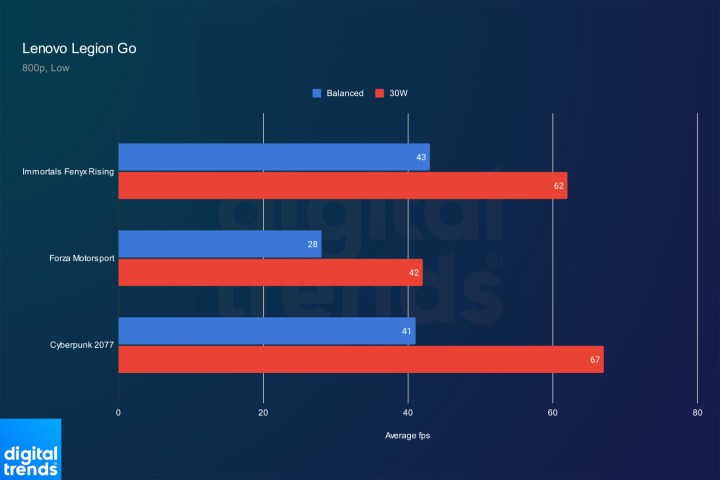
The Legion Go doesn’t give players a ton of ways to tweak their settings, but it meets the minimum for customization. Players have the option to swap between three resolutions, two refresh rates, and some OS power modes. More powerful are its thermal mode options, which let players dial the wattage anywhere from 5 to 30. That’s the most impactful tool in the suite, as games see a significant performance boost when maxing the slider out (in our tests, it saved 15 to 20 frames over the Balanced thermal setting).
That’s all great for 800p, but how does the handheld fare using its defining 1600p resolution? That’s a different story. The resolution boost demands maxed wattage in order to approach a smooth experience, and even that’s a tall order. Cyberpunk 2077 barely clears the 30 fps mark at 20W and Forza Motorsport taps out at 23 (both running in low settings). Bumping the wattage any lower produces some expectedly poor results. Immortals Fenyx Rising only hit the 21 fps mark in those tests, while Forza struggled at 15.
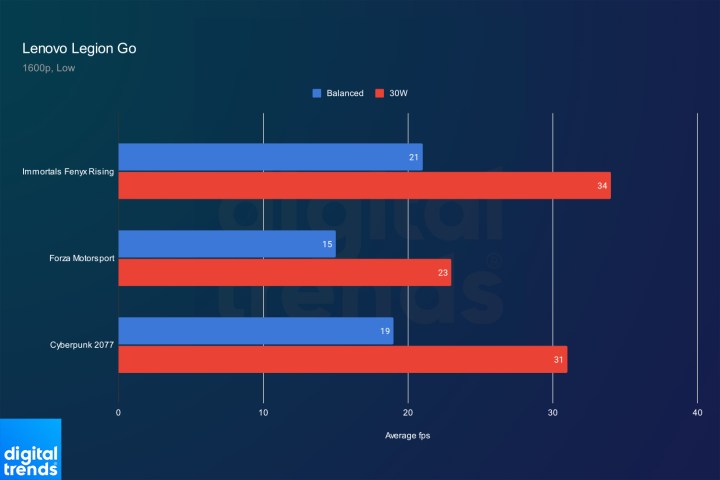
As you can imagine, great power comes at the expense of battery. In my battery drain tests, Cyberpunk 2077 took the device down to 0% in about two hours. That was running at 800p on a balanced thermal setting, which is on the lower end of the machine’s power. If you’re trying to hit smooth frame rates and high visual quality in modern games, the battery can easily drain in closer to an hour. None of this is too shocking, but I’ve found that the battery life doesn’t bug me as much as it did on the Ayaneo 2S. I have enough wattage and resolution customization options to get some extra life out of it. Though what’s more crucial is that the Legion Go’s staying power is greater in its tabletop mode, where I’d ideally leave it plugged in and maxed out anyways. It’s one of many areas where the added versatility works to Lenovo’s advantage here.
Onboard tools and UI
While power and performance are always a high priority with devices like this, a good user interface that makes it easy to use can go a long way. Just look at the Steam Deck, which has a clean SteamOS interface that makes it feel as polished as a home console. It’s an area that Lenovo unfortunately doesn’t nail down with the Legion Go, selling its impressive device short at launch.
The good (and sometimes bad) news is that the device runs Windows 11. It’s essentially a Windows tablet, which makes it easy to install and load up any game launcher. I was able to turn my machine into an ideal Xbox Game Pass device, playing games like Jusant on it from start to finish. There was some friction to get that going smoothly, as Windows has plenty of annoying quirks that are hard to work around on a smaller screen. It took a day of settings tweaking to get everything working right, and I hit some puzzling roadblocks along the way (like Diablo 4 freezing at the Blizzard logo every time I’s try to boot it), but many of the Legion Go’s problems are simply Windows problems you have to live with.
Legion Space is a low-quality tool that’ll need a lot of post-launch support.
What is within Lenovo’s control, however, is its poor Legion Space app. Like the ROG Ally, the Legion Go contains its own custom software that lets players tweak settings, organize games, and more. The app even has its own game storefront filled with exclusive deals. But as it stands now, Legion Space is a low-quality tool that’ll need a lot of post-launch support to get it in a healthy place. Text awkwardly wraps onto two lines, images are blurry, the app doesn’t consistently open when I press the menu buttons. It feels only a little more refined than Ayaneo’s custom app on its own devices.
Other quirks are downright weird. Pressing the right menu button opens the performance overlay, but when closing it and pressing it again, it opens up a left-side quick menu instead. It often takes three button presses to get to the menu you’re actually trying to access. When opening the performance menus, my inputs are still detected on the game below. A lot of these issues are fixable and I imagine we’ll see Lenovo steadily improve the tool over time just as Asus and Valve have done with their own devices. It just lends to the overall feeling that the Legion Go may have been rushed to market to capitalize on a moment.
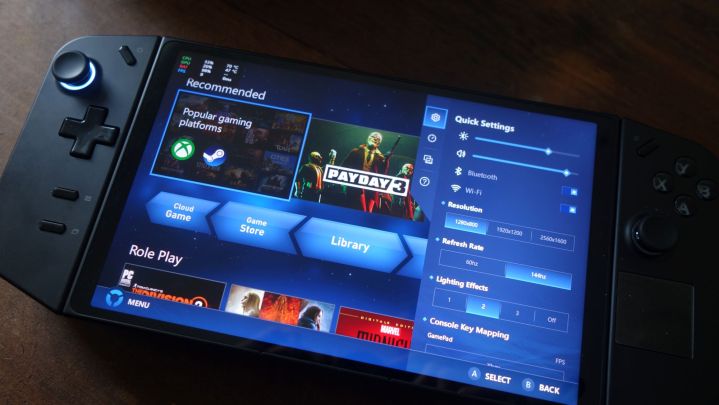
Like the Steam Deck, the Legion Go feels a bit like an experimental prototype that’ll pave the way for a better second model. Lenovo has its head in the right place when it comes to innovation, but there’s a lot of “proof of concept” work happening here. Its 1600p display isn’t really practical for gaming right now, its button layout is a mess, and Legion Space is no SteamOS at present. Even so, the creative handheld still stands out in a field that’s filling up fast. It fills a niche for those who still want to retain as much of the PC gaming experience as possible in a handheld. That use case won’t be enough to convince most people to drop another $700, but it’ll be a perfect fit for the right audience.
Sometimes that’s about the best result you can hope for when the competition is stiff.
Editors’ Recommendations
